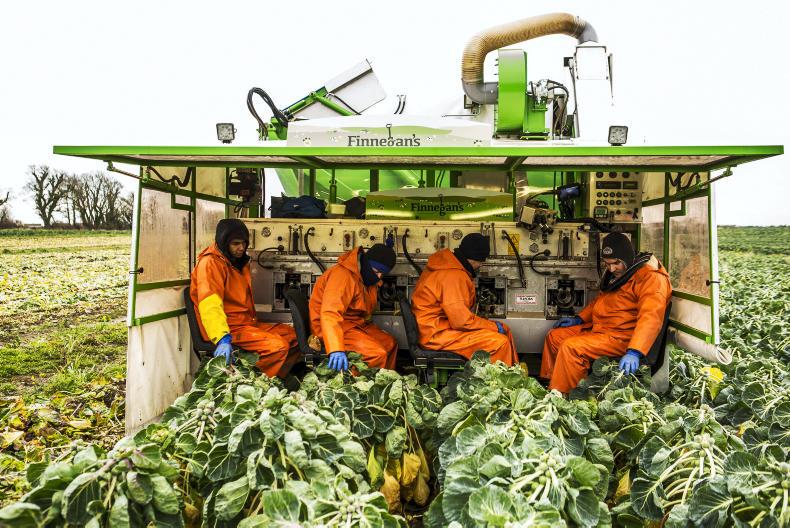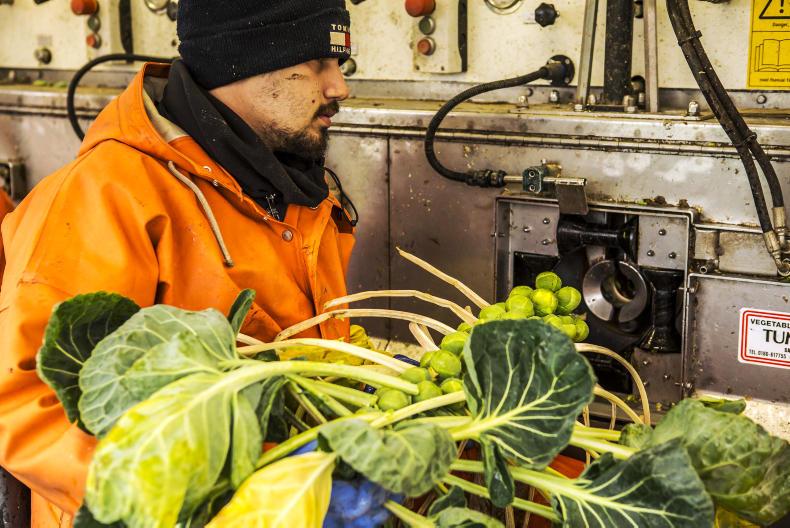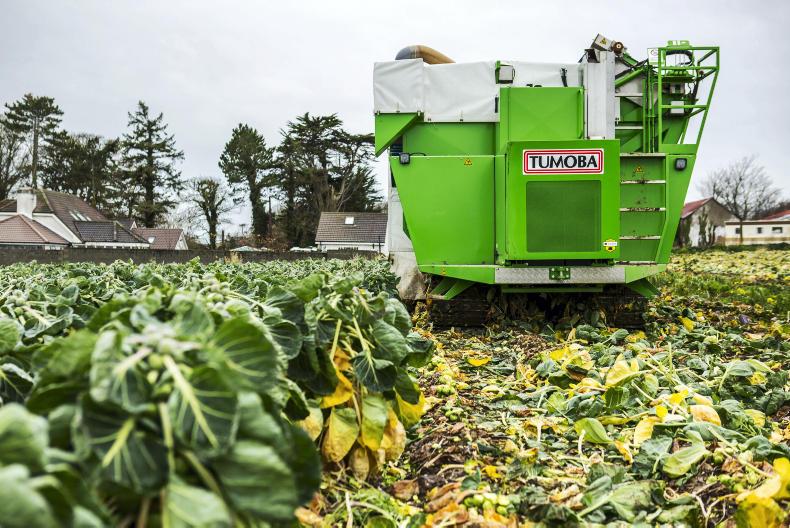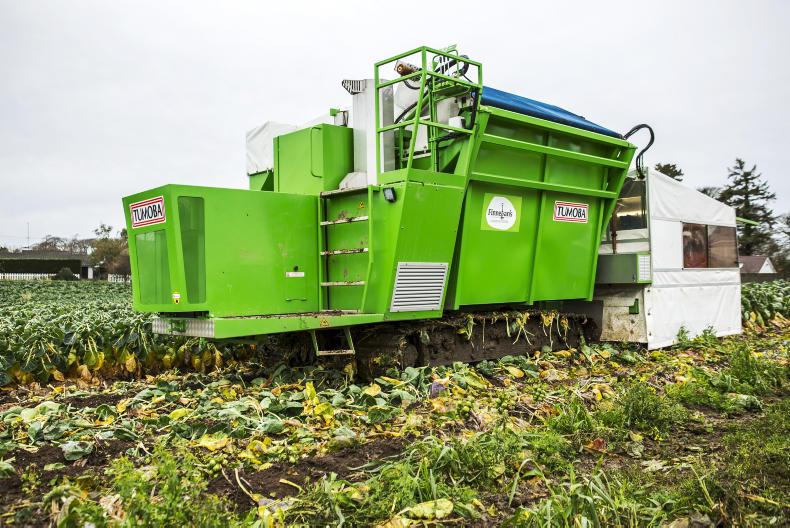Finnegan’s Farm is a family run operation based in Bellew, Balrath, Co Meath.
The main focus on the farm is tillage (cereals and potatoes). However, they also run a large herd of suckler cows.
In 2016, the Finnegans planted their first 20 acres of Brussels sprouts. A 1992 Tumoba two row harvester was imported from the Netherlands to harvest the crop.

Each person has to look after one row, so a four row machine requires four people etc. \ Philip Doyle
In 2017, they upped production to 45 acres. This year the family planted 60 acres, with plans to possibly grow more in the near future.
Why Brussels sprouts?
In 2016, the family decided that they wanted to introduce a vegetable into their crop rotation.
The vegetable of choice was the Brussels sprout, simply because of its growing season. The vegetable is planted in late May or early June and 70% of the harvesting takes place in December.
This means that both the staff and the machinery will have full-time work over the winter months.
Planting
The ground is ploughed in mid-May and left to dry. It is then rotavated twice and put into ridges.
The crop is planted in late May or early June using a specialised four-row planter.
One month after planting, the drills are ridged up in an attempt to strengthen the plant and to help reduce the impact of weeds.
The crop is grown in widths of 28m, with the tramlines currently being left vacant.
The Finnegans are using variable-rate fertiliser spreading on the crop. Throughout the growing season they occasionally fly a drone over the field to take pictures.
From these pictures, a fertiliser map is derived and input into the GPS system for the fertiliser spreader.
Harvester
Finnegan’s Farm is currently running two Tumoba Brussels sprout harvesters, one two-row machine previously mentioned and a new four-row harvester.
Last year, the management team on the farm took a trip to the Netherlands with the intention of purchasing a new harvester. A four-row machine which cost €280,000 was purchased over a two-row machine which would cost €180,000.
After cutting, the stalks are picked up by hand and fed into the stripper head. \ Philip Doyle
They purchased a second harvester because of the huge demand for the crop around the Christmas period.
Both machines will be running around the clock at maximum capacity for the week before Christmas. The four-row harvester has a throughput of around 2t/hr.
However, this is very much dependent on the plant conditions such as its height, the amount of leaves and whether or not the plant is standing straight. The machine operators will also have a big impact on throughput.
Workings of the machine
Initially these specialised machines may seem complicated. However, they are actually quite straightforward.
The operators are seated at the front of the machine. Each person has to look after one row, so a four-row machine requires four people, etc.
Each operator has a foot-controlled arm with a ripper blade which is used to cut the stalk. These stalks are then picked up by hand before being fed into the stripper head.
The stripper head will initially remove the leaves, discarding them on the ground. It will then remove the Brussels sprouts from the stalk, dropping them on to an elevator that carries them to the storage hopper at the rear of the machine.

The storage hopper has a 5t capacity. \ Philip Doyle
While travelling to the hopper, an inclined separating belt and a hoover system are both used to remove any leaves or unwanted debris that may have somehow found its way in with the Brussels sprouts.
The stripped stalks are chopped and returned back to the ground.
Controls and working environment
The control layout is relatively simple. Each operator can alter the knife pressure and the cutting height of their blade.
Like any tracked machine, there are two control handles, one for each track.

The machine runs tracks, each of which are three metres long and 60cm wide. This allows the harvester to operate on land at this time of the year. \ Philip Doyle
As the crop is planted using GPS, all rows are straight. The harvester has its own auto-steer system. When the storage hopper is full (5t capacity), the driver will be notified.
The driver can also monitor the storage hopper from his seat via a camera.
Each operator has their own seat and heater. The machine runs very quietly, which means the radio can be easily heard. If working in the rain, the front window can be lowered to ensure the operators don’t get wet.
The machine itself is resting on a set of tracks.
These tracks are 3m long and 60cm wide, ensuring the harvester can operate on land at this time of the year. It’s powered by a 125hp John Deere engine that runs at 2,200rpm.
Daily maintenance on the machine is as simple as topping up the auto greaser and filling the tank with diesel.
The crop
A good crop of sprouts will typically yield 6t/acre, with 5t to 5.5t of this ending up in the boxes.
The Finnegans are currently growing eight different varieties, each of which has varying maturation dates.
Quality control manager John Smith explained that the ideal plant of sprouts they are looking for will have a stalk height of 3ft.
The current spacing between their plants is 16in, with the hope of reducing this to 14in next year. This is to have a taller plant with a more even-sized sprout throughout the stalk. Typically, they aim to have 75 to 85 sprouts per plant.
The Brussels sprouts are transported back to the yard in sprout boxes where they are sized, graded and then pack into nets.
Finnegan’s Farm is a family run operation based in Bellew, Balrath, Co Meath.
The main focus on the farm is tillage (cereals and potatoes). However, they also run a large herd of suckler cows.
In 2016, the Finnegans planted their first 20 acres of Brussels sprouts. A 1992 Tumoba two row harvester was imported from the Netherlands to harvest the crop.

Each person has to look after one row, so a four row machine requires four people etc. \ Philip Doyle
In 2017, they upped production to 45 acres. This year the family planted 60 acres, with plans to possibly grow more in the near future.
Why Brussels sprouts?
In 2016, the family decided that they wanted to introduce a vegetable into their crop rotation.
The vegetable of choice was the Brussels sprout, simply because of its growing season. The vegetable is planted in late May or early June and 70% of the harvesting takes place in December.
This means that both the staff and the machinery will have full-time work over the winter months.
Planting
The ground is ploughed in mid-May and left to dry. It is then rotavated twice and put into ridges.
The crop is planted in late May or early June using a specialised four-row planter.
One month after planting, the drills are ridged up in an attempt to strengthen the plant and to help reduce the impact of weeds.
The crop is grown in widths of 28m, with the tramlines currently being left vacant.
The Finnegans are using variable-rate fertiliser spreading on the crop. Throughout the growing season they occasionally fly a drone over the field to take pictures.
From these pictures, a fertiliser map is derived and input into the GPS system for the fertiliser spreader.
Harvester
Finnegan’s Farm is currently running two Tumoba Brussels sprout harvesters, one two-row machine previously mentioned and a new four-row harvester.
Last year, the management team on the farm took a trip to the Netherlands with the intention of purchasing a new harvester. A four-row machine which cost €280,000 was purchased over a two-row machine which would cost €180,000.
After cutting, the stalks are picked up by hand and fed into the stripper head. \ Philip Doyle
They purchased a second harvester because of the huge demand for the crop around the Christmas period.
Both machines will be running around the clock at maximum capacity for the week before Christmas. The four-row harvester has a throughput of around 2t/hr.
However, this is very much dependent on the plant conditions such as its height, the amount of leaves and whether or not the plant is standing straight. The machine operators will also have a big impact on throughput.
Workings of the machine
Initially these specialised machines may seem complicated. However, they are actually quite straightforward.
The operators are seated at the front of the machine. Each person has to look after one row, so a four-row machine requires four people, etc.
Each operator has a foot-controlled arm with a ripper blade which is used to cut the stalk. These stalks are then picked up by hand before being fed into the stripper head.
The stripper head will initially remove the leaves, discarding them on the ground. It will then remove the Brussels sprouts from the stalk, dropping them on to an elevator that carries them to the storage hopper at the rear of the machine.

The storage hopper has a 5t capacity. \ Philip Doyle
While travelling to the hopper, an inclined separating belt and a hoover system are both used to remove any leaves or unwanted debris that may have somehow found its way in with the Brussels sprouts.
The stripped stalks are chopped and returned back to the ground.
Controls and working environment
The control layout is relatively simple. Each operator can alter the knife pressure and the cutting height of their blade.
Like any tracked machine, there are two control handles, one for each track.

The machine runs tracks, each of which are three metres long and 60cm wide. This allows the harvester to operate on land at this time of the year. \ Philip Doyle
As the crop is planted using GPS, all rows are straight. The harvester has its own auto-steer system. When the storage hopper is full (5t capacity), the driver will be notified.
The driver can also monitor the storage hopper from his seat via a camera.
Each operator has their own seat and heater. The machine runs very quietly, which means the radio can be easily heard. If working in the rain, the front window can be lowered to ensure the operators don’t get wet.
The machine itself is resting on a set of tracks.
These tracks are 3m long and 60cm wide, ensuring the harvester can operate on land at this time of the year. It’s powered by a 125hp John Deere engine that runs at 2,200rpm.
Daily maintenance on the machine is as simple as topping up the auto greaser and filling the tank with diesel.
The crop
A good crop of sprouts will typically yield 6t/acre, with 5t to 5.5t of this ending up in the boxes.
The Finnegans are currently growing eight different varieties, each of which has varying maturation dates.
Quality control manager John Smith explained that the ideal plant of sprouts they are looking for will have a stalk height of 3ft.
The current spacing between their plants is 16in, with the hope of reducing this to 14in next year. This is to have a taller plant with a more even-sized sprout throughout the stalk. Typically, they aim to have 75 to 85 sprouts per plant.
The Brussels sprouts are transported back to the yard in sprout boxes where they are sized, graded and then pack into nets.










 This is a subscriber-only article
This is a subscriber-only article

















SHARING OPTIONS: